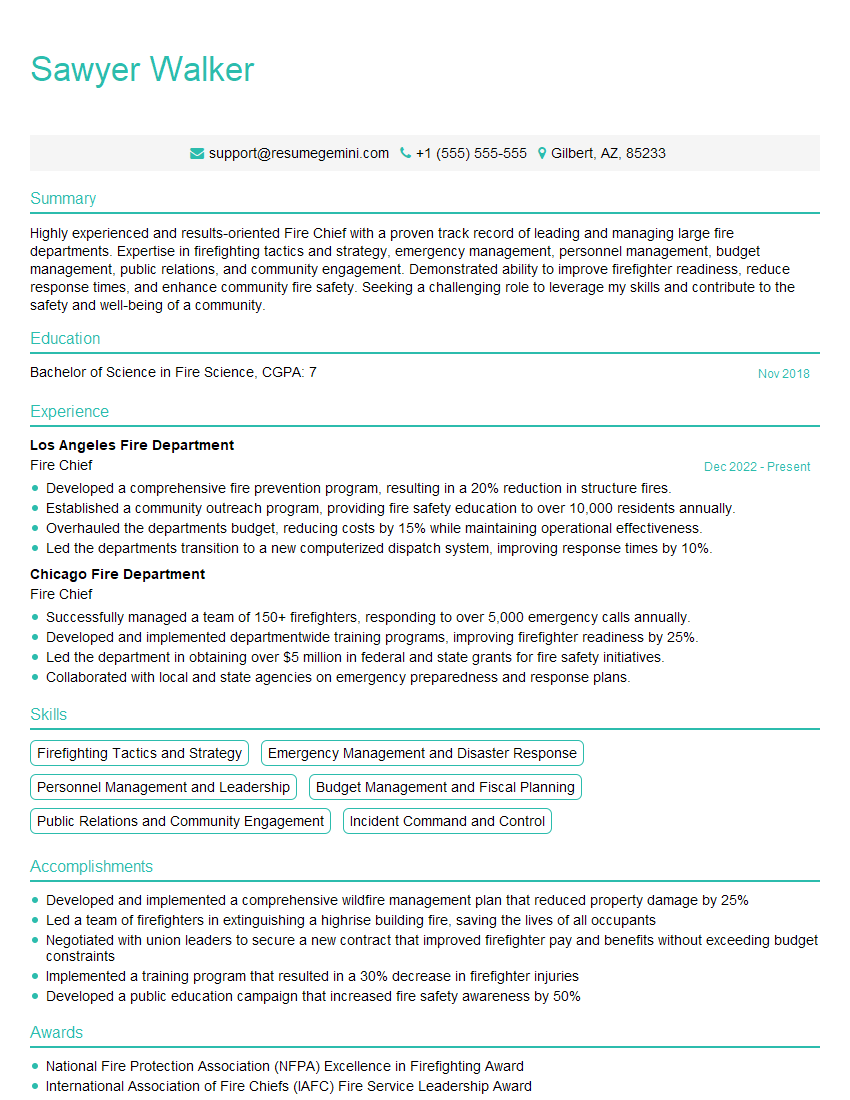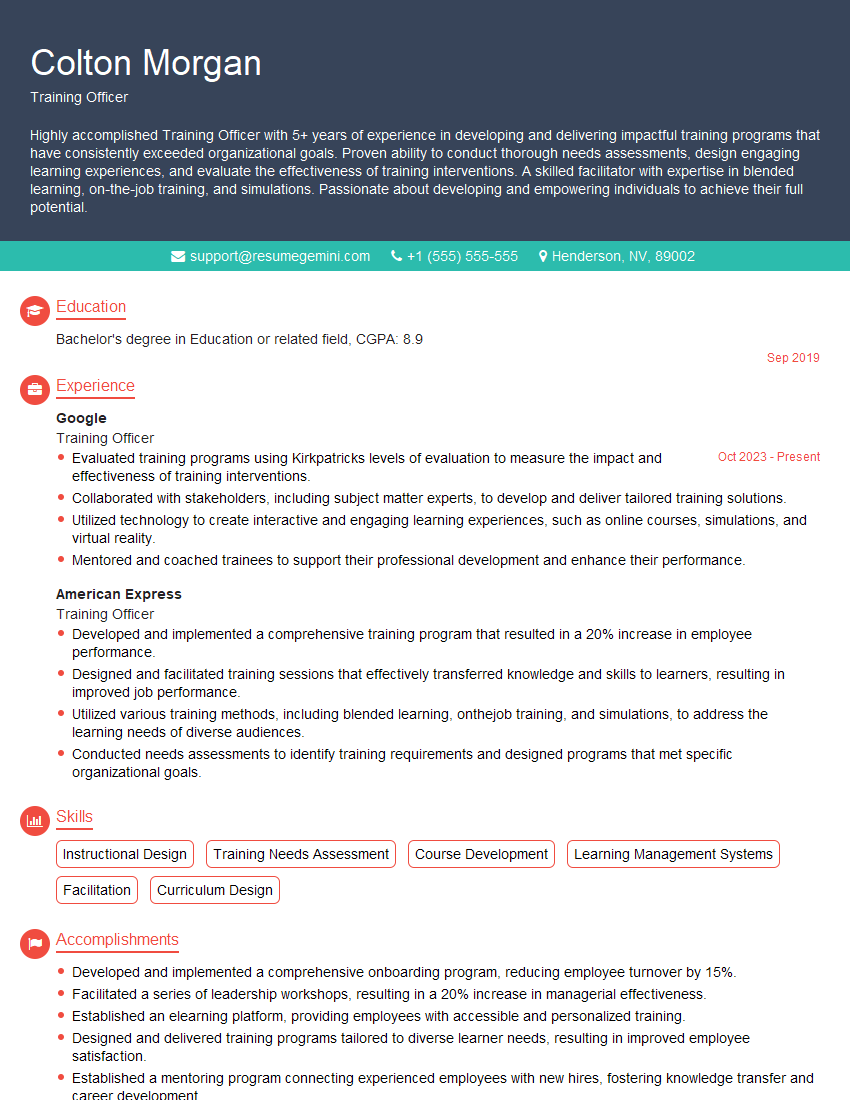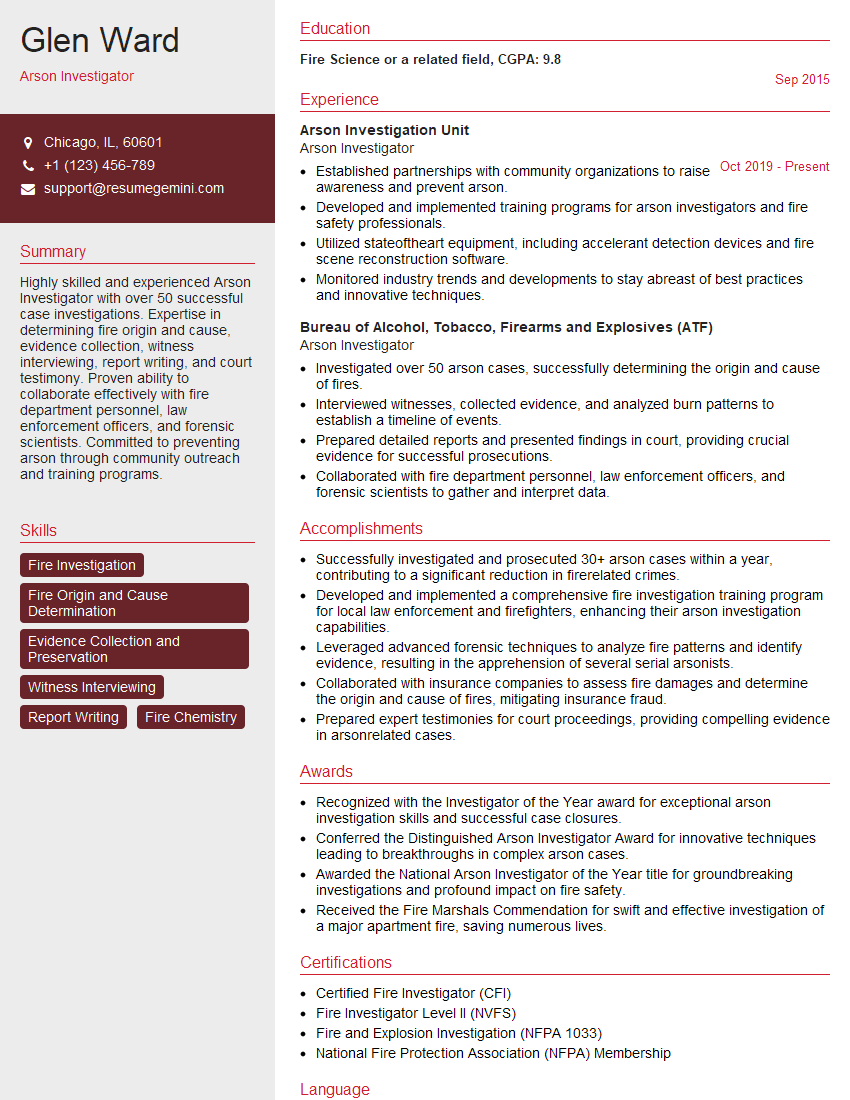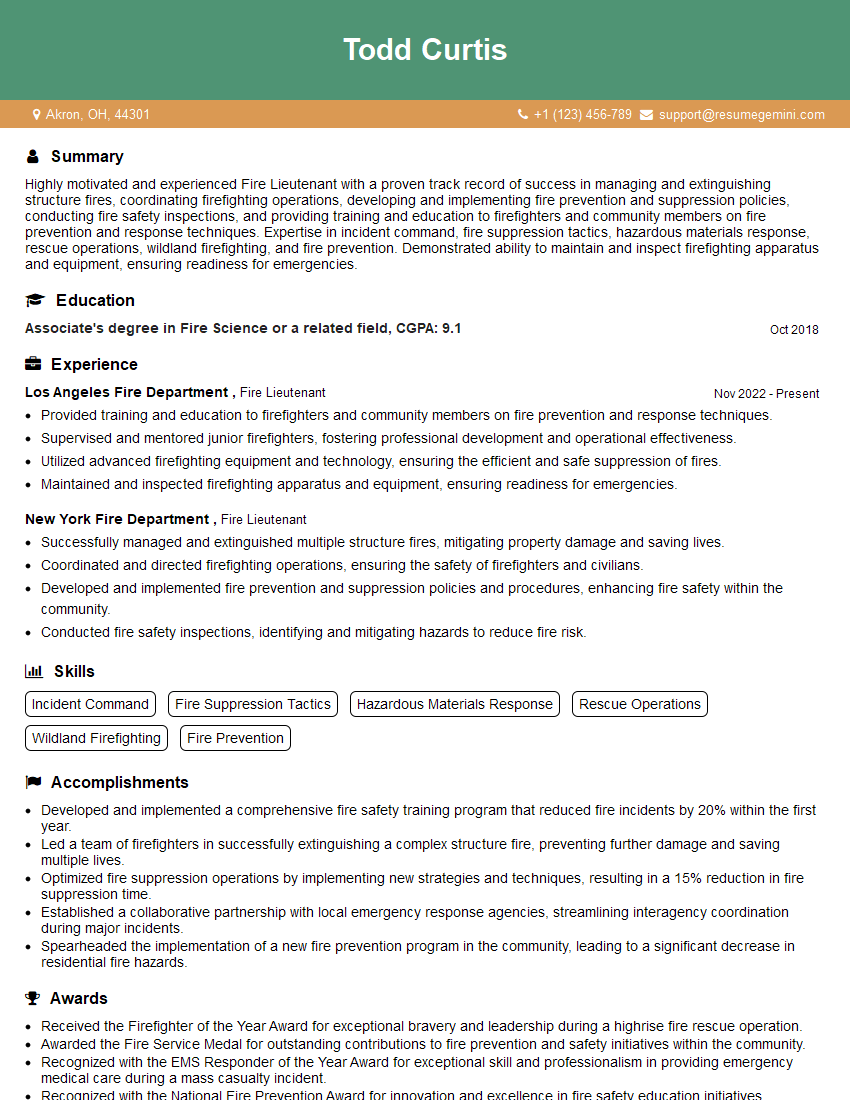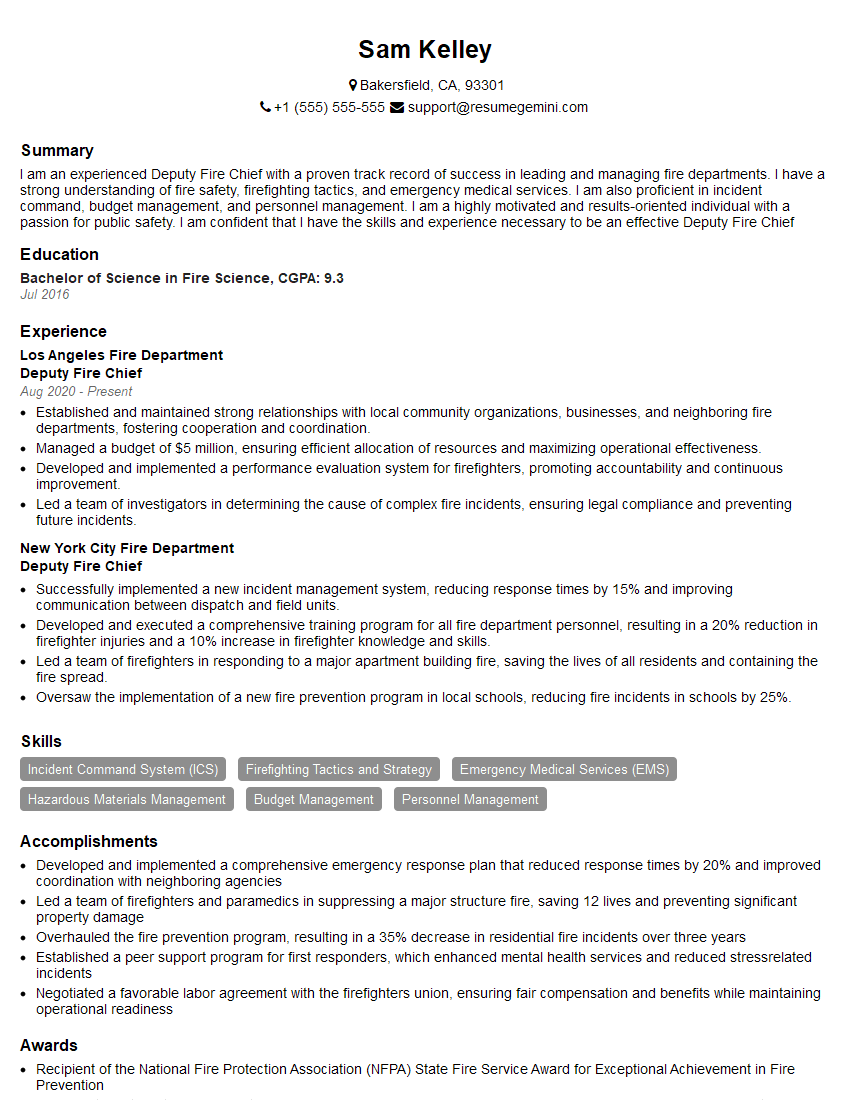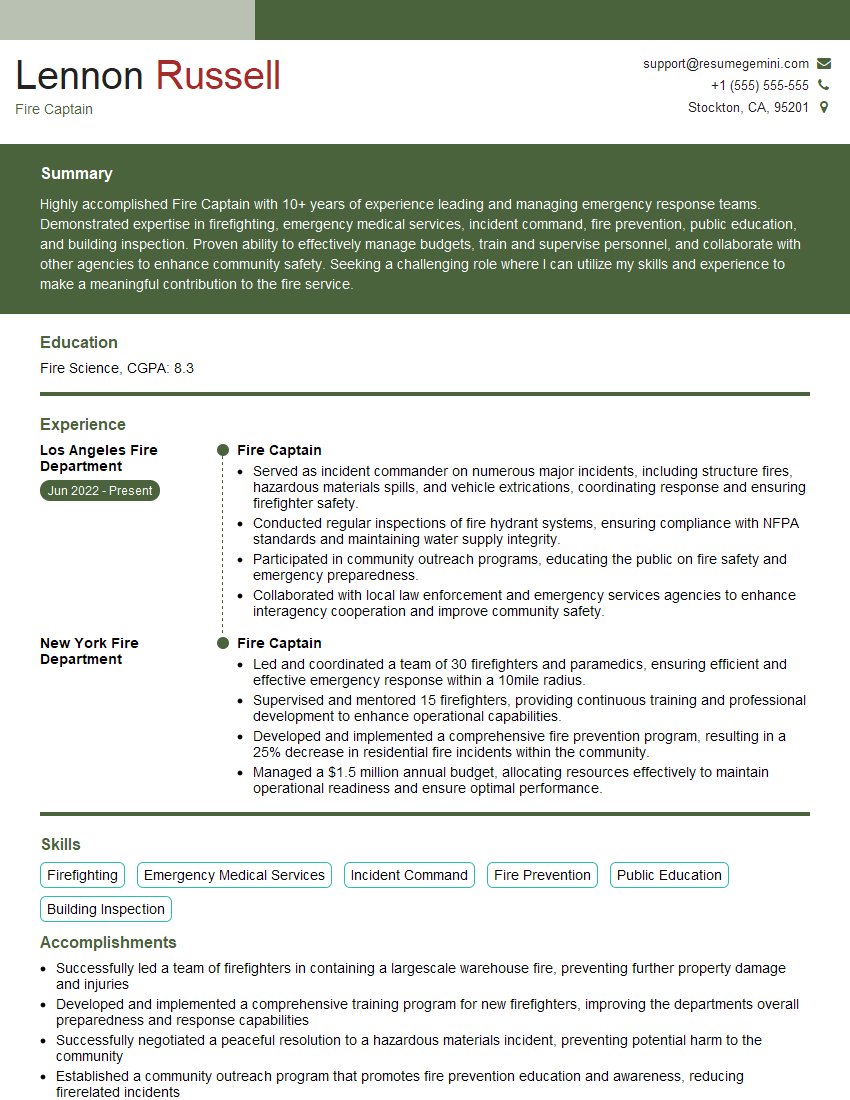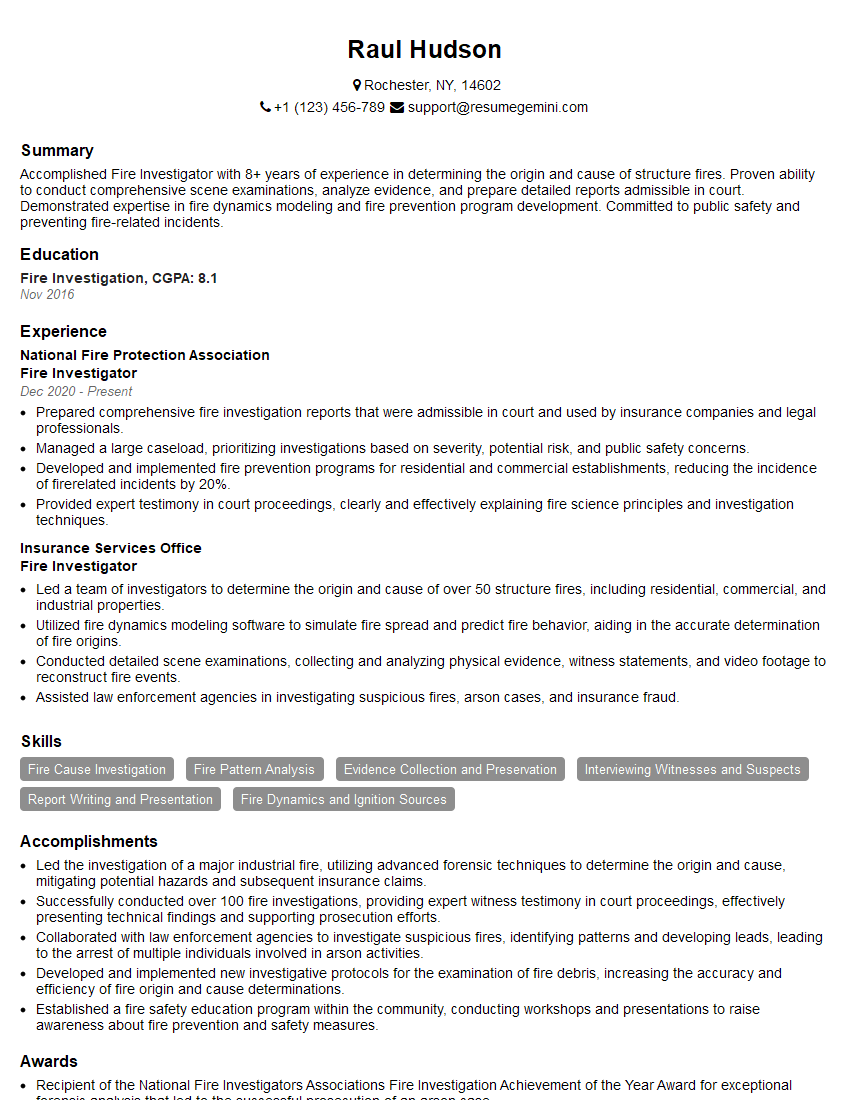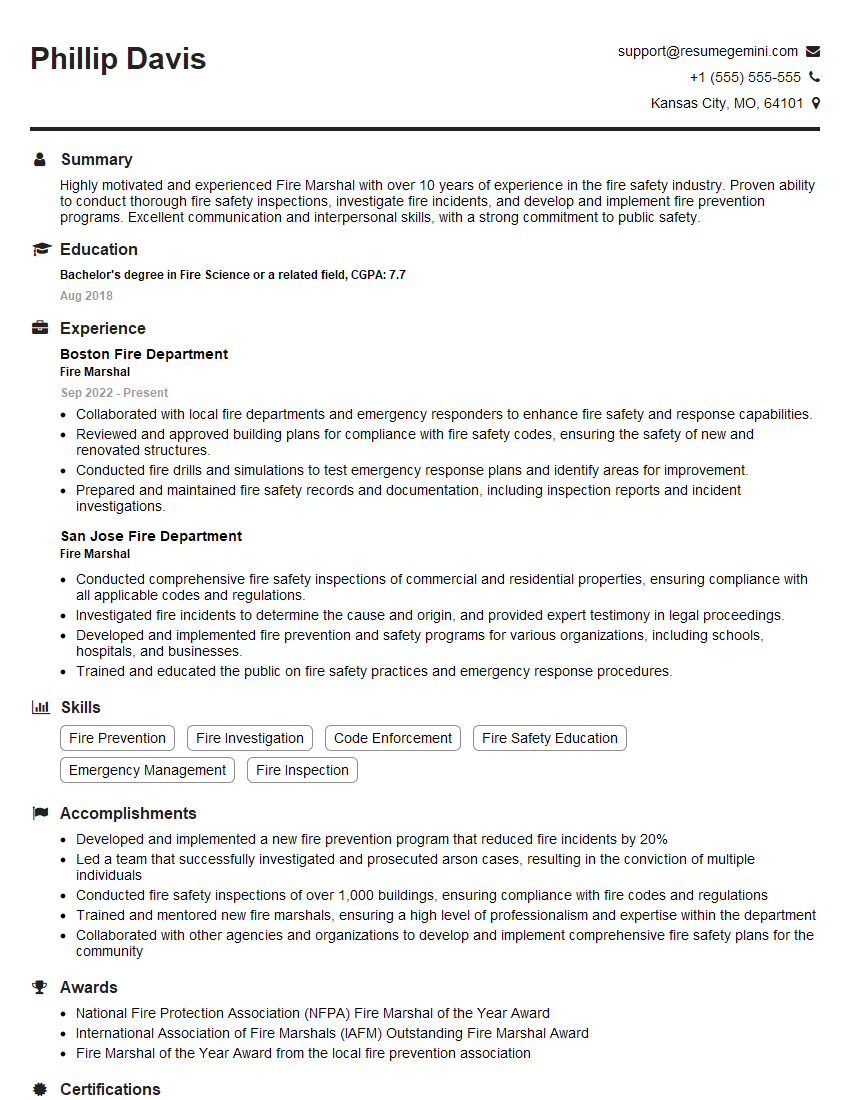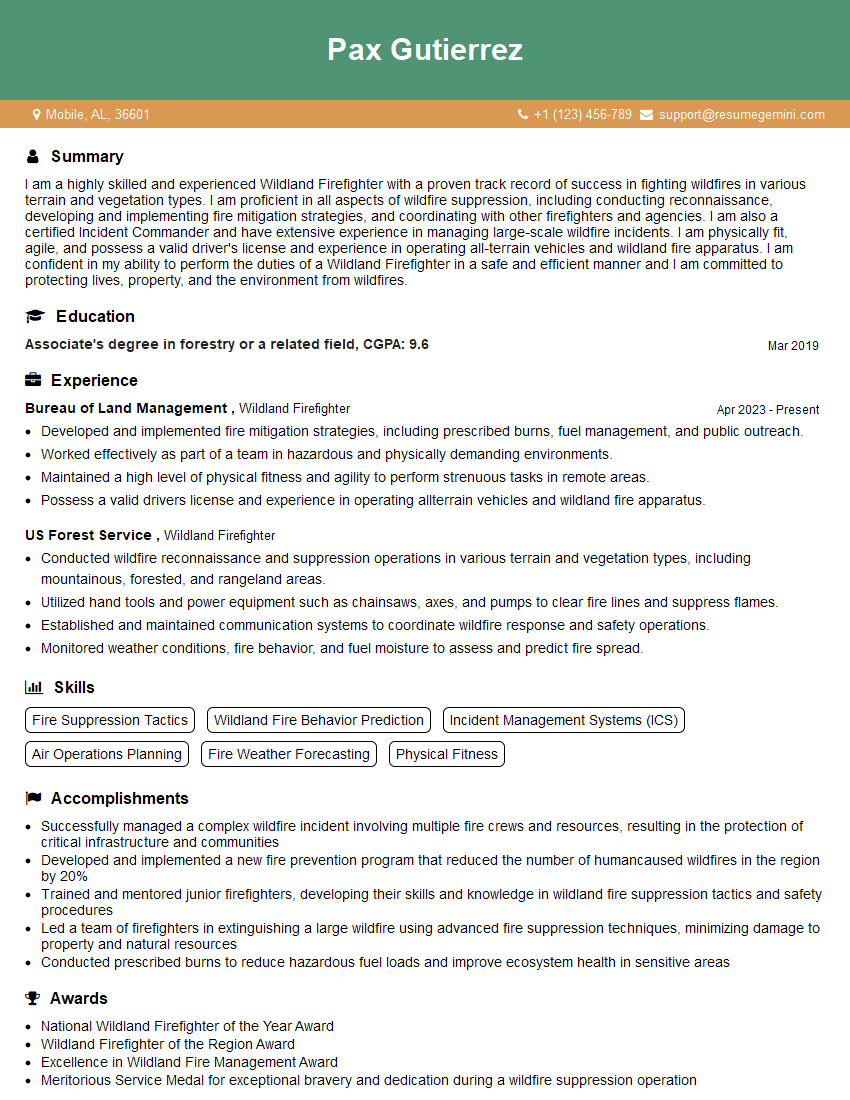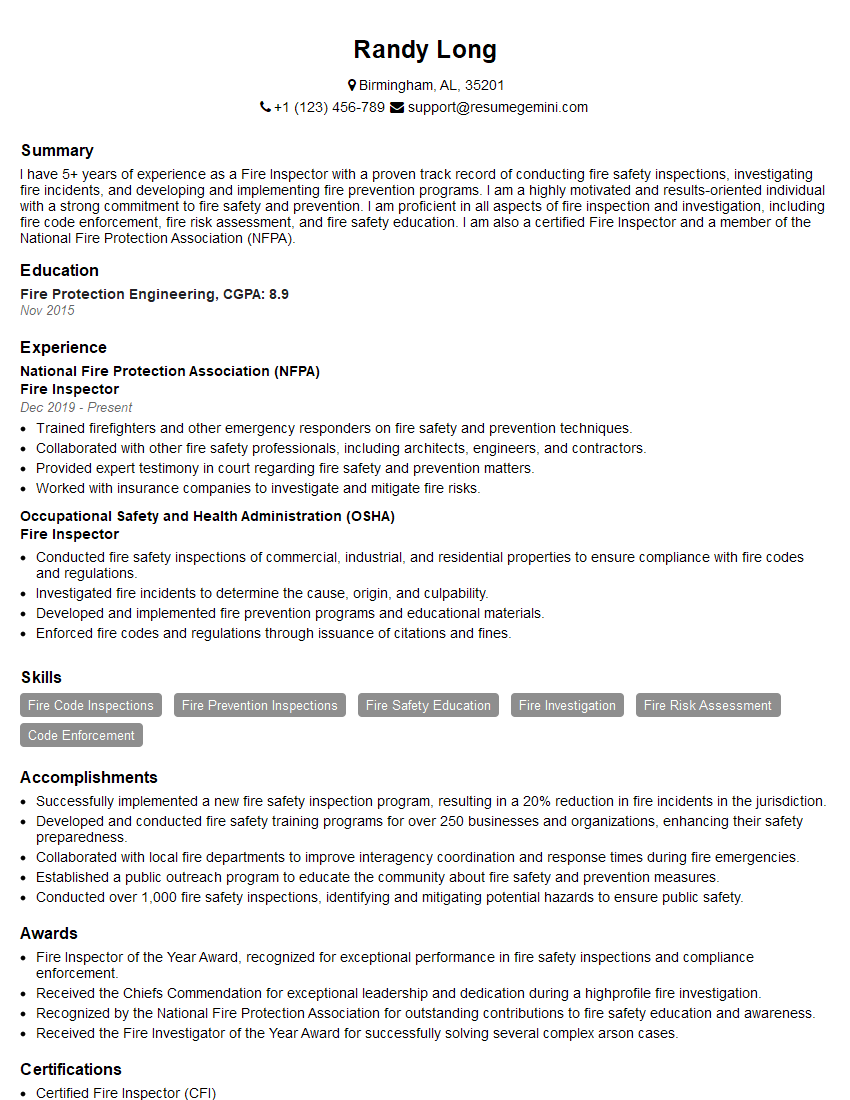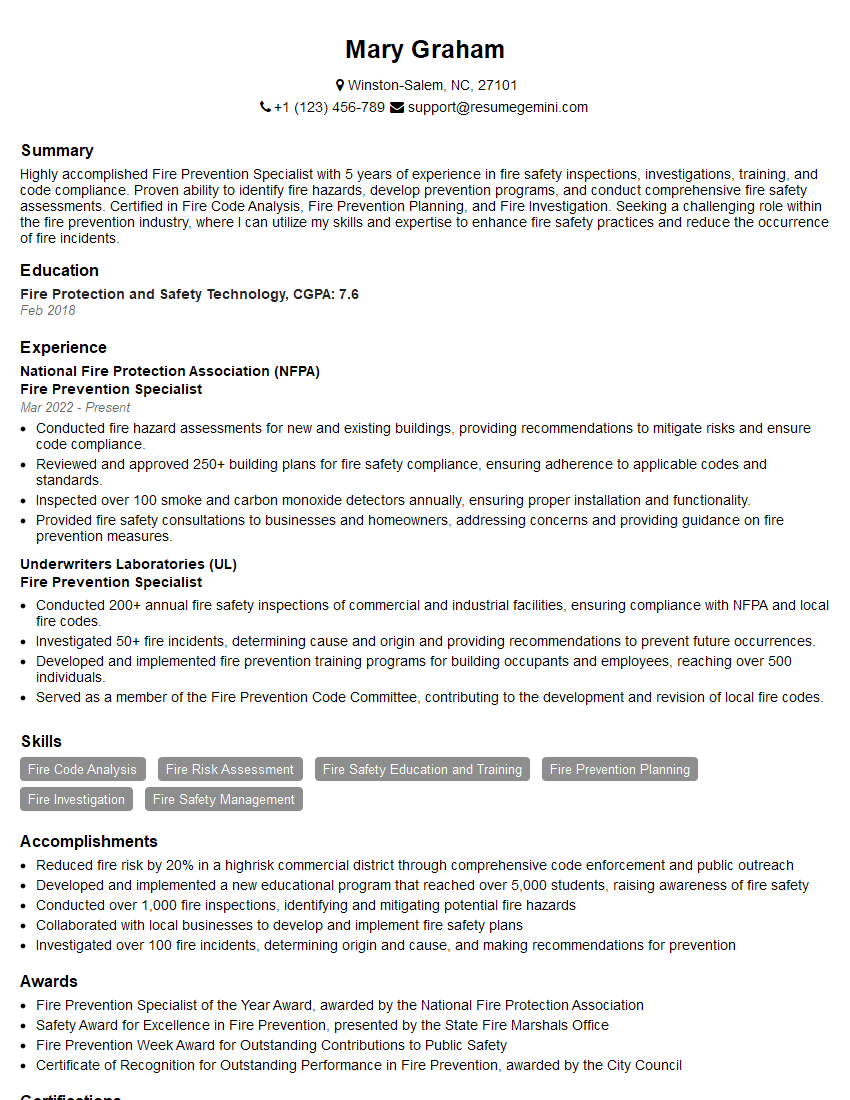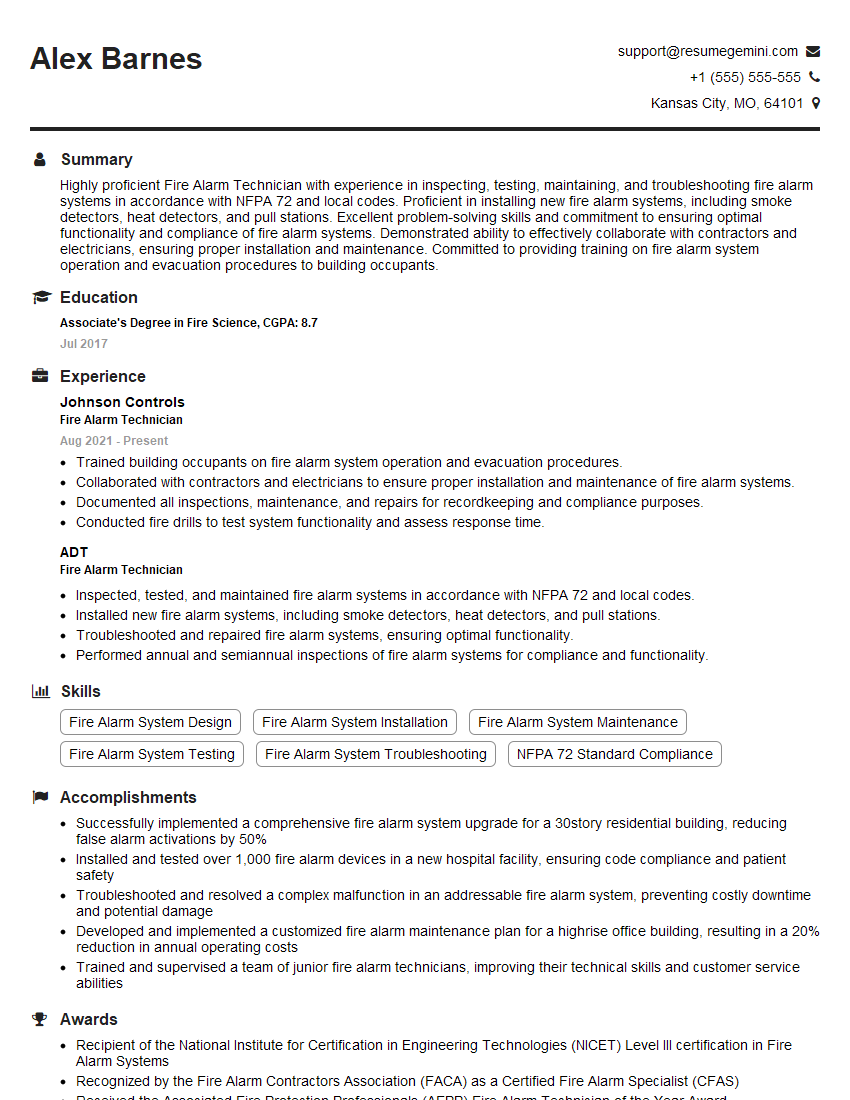Every successful interview starts with knowing what to expect. In this blog, we’ll take you through the top Firefighting Certification interview questions, breaking them down with expert tips to help you deliver impactful answers. Step into your next interview fully prepared and ready to succeed.
Questions Asked in Firefighting Certification Interview
Q 1. Describe the different classes of fire and the appropriate extinguishing agents for each.
Fires are classified into different classes based on the type of fuel involved, which dictates the most effective extinguishing agent. Understanding these classes is crucial for firefighters to choose the right tool for the job and prevent the fire from spreading.
- Class A Fires: These involve ordinary combustible materials like wood, paper, cloth, and plastics. The best extinguishing agent is water, which cools the fuel and reduces its temperature below the ignition point. Foam can also be effective.
- Class B Fires: These involve flammable liquids such as gasoline, oil, grease, and solvents. Water is generally not effective here, as it can spread the fire. Suitable agents include carbon dioxide (CO2), dry chemical powder, and foam, which work by smothering the fire and cutting off its oxygen supply.
- Class C Fires: These involve energized electrical equipment. Never use water on a Class C fire! The risk of electrocution is extremely high. Instead, use CO2 or dry chemical extinguishers, ensuring the power is cut off as soon as it’s safe to do so.
- Class D Fires: These involve combustible metals such as magnesium, titanium, and sodium. These fires require specialized extinguishing agents, typically dry powder designed for metal fires. Water can actually worsen these fires.
- Class K Fires: These involve cooking oils and fats in commercial kitchens. Class K extinguishers use a special wet chemical agent that saponifies (turns into soap) the grease, which helps to suppress the fire.
For example, imagine a grease fire in a restaurant kitchen (Class K). Using water would cause the hot oil to splatter, spreading the fire rapidly. A Class K extinguisher, however, would quickly neutralize the grease and extinguish the flames.
Q 2. Explain the PASS method for using a fire extinguisher.
The PASS method is a simple yet critical acronym for using a fire extinguisher effectively and safely. Remember PASS: Pull, Aim, Squeeze, Sweep.
- Pull: Pull the pin on the extinguisher, breaking the safety seal.
- Aim: Aim the nozzle at the base of the fire, not the flames themselves. Targeting the base ensures you extinguish the fuel source.
- Squeeze: Squeeze the lever or handle to discharge the extinguishing agent.
- Sweep: Sweep the nozzle from side to side, covering the base of the fire until it’s extinguished. Keep a safe distance from the flames.
Imagine a small trash can fire in an office. You would pull the pin, aim at the base of the burning trash, squeeze the handle to release the extinguisher’s contents, and sweep the nozzle side-to-side until the fire is completely out. Always ensure your escape route is clear before attempting to extinguish the fire.
Q 3. What are the key components of a fire triangle/tetrahedron?
The fire triangle illustrates the three essential elements needed for a fire to exist: fuel, heat, and oxygen. Removing any one of these elements will extinguish the fire. The fire tetrahedron adds a fourth element: a chemical chain reaction. This chain reaction sustains the combustion process and allows the fire to continue burning.
- Fuel: Any material that can burn, such as wood, paper, gas, or liquids.
- Heat: The energy required to initiate and sustain combustion. The heat source can be a flame, spark, or even friction.
- Oxygen: The oxidizer that supports combustion. Air typically contains about 21% oxygen.
- Chemical Chain Reaction: The continuous process of oxidation that creates more heat, sustaining the fire.
Think of a campfire: wood (fuel) is ignited by a match (heat), and the burning wood consumes oxygen from the air, creating a chain reaction that keeps the fire burning until the fuel is consumed or oxygen is cut off. Understanding the fire tetrahedron allows firefighters to strategize effective fire suppression by targeting one or more of these elements.
Q 4. Outline the steps involved in a building fire evacuation.
Evacuating a building during a fire is a critical procedure requiring a structured approach. A well-practiced evacuation plan minimizes risk to life and property.
- Activate the Alarm: Sound the alarm system to alert building occupants.
- Evacuation Order: Give clear and concise evacuation instructions to personnel.
- Account for Personnel: Ensure all occupants are accounted for, potentially using a designated roll call point.
- Designated Escape Routes: Ensure occupants are familiar with and use pre-determined escape routes.
- Assembly Point: Have a designated assembly point outside the building to confirm everyone is safe and to take headcount.
- Emergency Services Notification: Contact emergency services (e.g., 911) immediately.
- Post-Evacuation Procedures: Follow established post-evacuation procedures, including preventing re-entry until authorities declare it safe.
Regular fire drills are essential for practicing these steps and ensuring everyone knows what to do in an emergency. Clear signage and easily accessible escape routes are crucial for a successful evacuation. Remember, ‘RACE’ (Rescue, Alarm, Confine, Extinguish/Evacuate) is a helpful acronym for initial response in smaller fires before full evacuation is necessary.
Q 5. Describe the different types of breathing apparatus and their limitations.
Breathing apparatus (BA) is essential for firefighters operating in hazardous environments where there’s a risk of smoke inhalation or oxygen deficiency. Several types exist, each with limitations.
- Self-Contained Breathing Apparatus (SCBA): The most common type, SCBAs provide a self-contained supply of air for a specified duration. Limitations include weight, limited air supply, and potential for malfunction.
- Supplied-Air Respirators (SARs): These respirators receive air from an external source through a hose, often used in confined spaces. The hose’s length is a major limitation, restricting movement. Air supply disruptions can also be dangerous.
- Escape Respirators: These provide a short duration of breathable air for escape from hazardous environments. They are not designed for prolonged use or firefighting operations.
For example, an SCBA is crucial for firefighters tackling a major building fire where smoke and toxic gases are present. An SAR might be used during confined space rescue where a continuous air supply is needed. However, the length of the air hose with an SAR needs careful consideration. Escape respirators are useful for quick escapes from a suddenly dangerous situation.
Q 6. Explain the importance of personal protective equipment (PPE) in firefighting.
Personal Protective Equipment (PPE) is paramount for firefighter safety, protecting them from the various hazards inherent in firefighting. It’s a critical component of a firefighter’s survival.
- Structural Firefighting Gear: This includes protective coats, trousers, helmets, gloves, and boots made of fire-resistant materials. It protects against heat, flames, and impacts.
- Self-Contained Breathing Apparatus (SCBA): Protects against smoke inhalation and oxygen deficiency.
- Eye Protection: Goggles or face shields protect against debris, heat, and harmful chemicals.
- Hearing Protection: Ear plugs or muffs protect against loud noises from equipment and explosions.
Imagine a firefighter battling a raging inferno. Without PPE, the intense heat, flames, and toxic smoke would severely injure or kill them. The PPE acts as a barrier, allowing firefighters to perform their tasks safely and effectively. Regular inspection and maintenance of PPE are crucial for ensuring its continued effectiveness.
Q 7. What are the common hazards associated with confined space rescue?
Confined space rescue presents unique challenges and hazards due to the limited access, ventilation, and potential for atmospheric hazards. Understanding these hazards is crucial for safe rescue operations.
- Oxygen Deficiency: Lack of sufficient oxygen can cause unconsciousness and death.
- Toxic Atmospheres: Presence of hazardous gases such as carbon monoxide, hydrogen sulfide, or methane can be lethal.
- Flammable Atmospheres: Presence of flammable gases or vapors increases the risk of explosions.
- Confined Space Geometry: Difficult access, limited visibility, and challenging physical layout complicate rescue efforts.
- Entrapment: Individuals can become trapped or injured within the confined space, hindering rescue attempts.
For instance, a worker trapped in a silo presents a confined space rescue scenario. Before entry, rescuers must test the atmosphere for oxygen levels, toxic gases, and flammable substances. Appropriate PPE, including SCBA and specialized equipment, is crucial for a safe rescue. A detailed rescue plan, including entry and exit strategies, is essential for success.
Q 8. How do you assess a hazardous materials incident?
Assessing a hazardous materials incident requires a systematic approach prioritizing safety. It begins with recognizing the potential hazard – is it a spill, leak, or release? What material is involved? This often requires initial identification through visual inspection, placards on containers, or Safety Data Sheets (SDS).
Next, I’d establish a perimeter, controlling access to prevent further exposure. This involves evaluating the immediate danger zone and establishing safe distances based on the material’s properties (explosive, flammable, toxic, etc.). Specialized monitoring equipment, such as gas detectors or radiation meters, would be employed to confirm the presence and concentration of hazardous substances.
Then, I’d begin the process of identifying the material. This could involve examining the packaging, checking for markings, contacting the shipper, or using field testing kits. Once identified, the SDS provides crucial information about its hazards, first aid measures, and appropriate containment and cleanup procedures. I would then communicate findings to command and develop a strategy based on the hazard assessment. For example, a highly volatile flammable liquid might demand a rapid evacuation, while a less volatile toxic substance could require more focused containment and cleanup measures.
This whole process relies heavily on teamwork and clear communication. It’s about gathering information, making informed decisions, and ensuring everyone involved understands the risks and the plan of action.
Q 9. Describe your understanding of incident command systems (ICS).
The Incident Command System (ICS) is a standardized, on-scene management system designed to aid in the efficient and effective handling of incidents of all sizes, from small brush fires to large-scale disasters. It’s based on a modular organizational structure, meaning it can be scaled up or down as needed. Think of it like a well-organized toolbox – you choose the right tools for the job.
Key components include the Incident Commander (IC), who holds overall responsibility for all incident operations; a Public Information Officer (PIO) for managing communication; a Safety Officer for ensuring responder safety; a Liaison Officer for coordinating with external agencies; and various functional sections such as Operations, Planning, Logistics, and Finance/Administration. Each section has a designated leader who reports to the IC.
The strength of ICS lies in its clear lines of authority and responsibility. This prevents confusion and duplication of efforts, ensuring a coordinated response. I’ve used ICS numerous times during wildfire suppression, where clear communication and coordinated resource allocation are critical for success. For example, during a large wildfire, one section might focus on fire suppression while another manages the evacuation of residents, all under the direction of the IC.
Q 10. Explain the role of a firefighter in a search and rescue operation.
A firefighter’s role in search and rescue is multifaceted and demanding, requiring specialized training and equipment. The primary goal is to locate and safely remove victims from hazardous environments. This might involve searching collapsed structures after an earthquake, navigating smoke-filled buildings during a fire, or searching flooded areas after a storm.
This often involves using specialized equipment like thermal imaging cameras to detect heat signatures in obscured environments, and listening devices to detect sounds of trapped victims. Search techniques can range from systematic grid searches to more targeted approaches based on information received from witnesses or other first responders. Once a victim is located, the firefighter must carefully assess the situation, ensuring their own safety as well as the victim’s before initiating extraction. This might involve stabilizing the environment, using specialized rescue tools to access the victim, and providing immediate medical attention as needed.
In my experience, effective communication within the rescue team is crucial. A clear understanding of the environment and the victim’s location is key to a successful and safe rescue. A well-coordinated team can quickly and efficiently locate victims and bring them to safety.
Q 11. What are the signs of potential building collapse?
Identifying potential building collapse requires keen observation and understanding of structural mechanics. Several warning signs indicate potential failure:
- Obvious cracks in walls, floors, or foundations: Large, widening cracks, especially those running diagonally, suggest serious structural damage.
- Leaning walls or columns: Noticeable tilting indicates significant stress on the structure.
- Sagging roofs or floors: Drooping roofs or floors suggest structural weakening.
- Protruding reinforcement bars: Rebar sticking out from concrete signifies concrete spalling and potential structural failure.
- Sounds of cracking or shifting within the structure: Creaking, groaning, or popping sounds can indicate movement and weakening.
- Recent significant damage from an event: Impact from fire, explosion, or earthquake is a major risk factor.
It’s vital to remember that these signs don’t always mean imminent collapse, but they do warrant immediate evacuation and professional structural engineering assessment. Ignoring these warnings could have fatal consequences.
Q 12. How would you handle a situation where a fellow firefighter is injured?
Handling a fellow firefighter’s injury involves a swift and coordinated response, prioritizing immediate safety and medical attention. The first step is to ensure the scene is safe for both the injured firefighter and the rescuers. This may involve extinguishing a fire or removing the injured individual from a hazardous area.
Once the scene is secured, I would immediately initiate first aid, focusing on controlling bleeding, stabilizing the injured firefighter, and providing comfort. We’re trained in advanced first aid and trauma care, and knowing the correct procedures for specific injuries is paramount. Simultaneously, I would request advanced medical assistance, providing a clear description of the injury, location, and the status of the casualty. Effective communication with dispatch and EMS is essential for a quick and appropriate response.
After the injured firefighter receives medical attention, there would be a thorough post-incident analysis to determine what happened, what went wrong, and what could be improved to prevent similar incidents in the future. The well-being of our team is paramount. We’re a family, and we take care of each other.
Q 13. Describe your experience with hydraulic rescue tools.
I have extensive experience with hydraulic rescue tools, also known as ‘jaws of life.’ These tools are indispensable for extricating victims trapped in vehicles or other confined spaces. My training covers their safe operation, maintenance, and the various techniques for their effective use in different rescue scenarios.
This includes using spreaders to separate metal, cutters to cut through steel, and rams to lift or move heavy objects. Proficiency requires understanding the tool’s limitations and potential hazards, such as kickback. I’m familiar with different models and their capabilities, and I know how to troubleshoot common problems. Safety is paramount – using the tools correctly minimizes the risk of injury to both the rescuers and the victim.
I’ve used these tools in numerous extrications, from simple car accidents to complex vehicle collapses. Each situation presents unique challenges requiring adaptable and precise techniques. For example, extracting someone trapped in a crushed vehicle requires a delicate balance of power and precision to avoid causing further injury.
Q 14. What is the procedure for entering a burning building?
Entering a burning building is a high-risk operation, demanding strict adherence to established procedures and teamwork. Safety is always the paramount concern.
The first step involves a thorough size-up – assessing the building’s layout, the fire’s location and intensity, and potential hazards. This informs decisions about entry points and strategies. Then, I would ensure all protective equipment is donned correctly, including self-contained breathing apparatus (SCBA), turnout gear, and helmet. A search and rescue team is usually formed and entry should be done in pairs or teams.
Once inside, a systematic search pattern is followed, using our training and experience to locate victims and navigate the challenging environment. Communication is maintained throughout the operation to prevent becoming disoriented and separated from our team. We use a communication system to stay in constant contact, especially in zero visibility conditions. If conditions become too dangerous, immediate withdrawal from the building is essential. The safety of the team is the priority – no rescue is worth a life.
Q 15. Explain the importance of post-incident analysis.
Post-incident analysis is critically important for continuous improvement in firefighting. It’s essentially a structured review of a fire incident to identify what went well, what could have been improved, and how to prevent similar incidents in the future. Think of it as a post-game analysis for a sports team, but with potentially life-altering consequences.
- Identifying Strengths: We analyze successful strategies, efficient teamwork, and the effective use of resources. For example, if a rapid deployment of a hose line successfully contained a fire’s spread, we document that tactic for future training and emulation.
- Pinpointing Weaknesses: We meticulously examine areas where performance fell short. This might include delays in response time, communication breakdowns, or equipment malfunctions. If a certain type of ladder proved inadequate for a specific situation, we’d evaluate its suitability and consider alternatives.
- Developing Actionable Solutions: The goal isn’t just to identify problems but to formulate concrete solutions. This might involve revising Standard Operating Procedures (SOPs), improving training programs, or acquiring new equipment. For instance, if communication issues arose, we might implement new radio protocols or invest in improved communication technology.
- Preventing Future Incidents: Ultimately, post-incident analysis aims to prevent future incidents through proactive measures. By learning from past mistakes and celebrating successes, we constantly refine our firefighting techniques and improve our overall effectiveness.
Career Expert Tips:
- Ace those interviews! Prepare effectively by reviewing the Top 50 Most Common Interview Questions on ResumeGemini.
- Navigate your job search with confidence! Explore a wide range of Career Tips on ResumeGemini. Learn about common challenges and recommendations to overcome them.
- Craft the perfect resume! Master the Art of Resume Writing with ResumeGemini’s guide. Showcase your unique qualifications and achievements effectively.
- Don’t miss out on holiday savings! Build your dream resume with ResumeGemini’s ATS optimized templates.
Q 16. How do you maintain your physical fitness for firefighting?
Maintaining peak physical fitness is paramount for a firefighter. The job demands incredible strength, endurance, and agility. My routine centers around a holistic approach, focusing on cardiovascular health, strength training, and flexibility.
- Cardiovascular Training: I regularly engage in activities like running, swimming, and cycling to build stamina and endurance. This is crucial for handling the intense physical demands of battling a fire. Think of it like marathon training, but with the added challenge of wearing heavy gear in extreme conditions.
- Strength Training: I incorporate weight training to build muscle strength and power. This is essential for tasks like carrying equipment, forcing entry into buildings, and rescuing victims. I focus on compound exercises that work multiple muscle groups simultaneously, mirroring the multifaceted nature of firefighting.
- Flexibility and Mobility: Maintaining flexibility is key to preventing injuries. Yoga and stretching help improve range of motion, critical for navigating confined spaces and maneuvering heavy equipment. Think of a contortionist – their flexibility is similar to what we need to navigate tight spaces.
- Nutrition and Hydration: A balanced diet and sufficient hydration are vital for optimal performance and recovery. Staying well-fueled is as important as the training itself.
Q 17. Describe your experience with ladder operations.
I have extensive experience with ladder operations, encompassing both ground and aerial ladders. My training includes various ladder climbs, rescues, and ventilation techniques.
- Ground Ladders: I’m proficient in raising, securing, and operating ground ladders of different types and sizes. This includes proper placement for access, rescue, and ventilation.
- Aerial Ladders: I’m experienced in operating aerial ladders, including raising, positioning, and securing them for rescue and firefighting operations at height. This also involves understanding weight limits and safety protocols.
- Rescue Techniques: My training emphasizes safe and efficient rescue techniques using ladders, including victim retrieval and lowering.
- Ventilation: I understand how to use ladders for ventilation purposes, creating openings to release smoke and heat from burning structures.
- Safety Procedures: I’m rigorously trained on all safety procedures related to ladder operations, including proper inspection, maintenance, and the use of personal protective equipment (PPE).
For instance, I was part of a team that used a 100-foot aerial ladder to rescue a person trapped on a burning building’s upper floors. Precise ladder placement and teamwork were crucial for a successful rescue.
Q 18. Explain the different types of fire suppression systems.
Fire suppression systems are designed to detect and extinguish fires automatically or to help firefighters control them. They vary greatly depending on the type of fire hazard and the building’s characteristics.
- Water-based Systems: These are the most common, using water sprinklers or hose systems to extinguish fires by cooling the burning material below its ignition temperature. Different sprinkler systems exist (wet pipe, dry pipe, deluge) depending on the application and risk.
- Foam Systems: These systems use foam to smother fires, cutting off their oxygen supply. Foam is particularly effective on flammable liquid fires.
- Gas Suppression Systems: These systems use inert gases like carbon dioxide or Argonite to displace oxygen, suffocating the fire. They’re often used in areas where water could cause damage, such as server rooms or electrical equipment rooms.
- Dry Chemical Systems: These systems use dry chemical agents to interrupt the chemical chain reaction of fire. They’re effective on class B and C fires (flammable liquids and electrical fires).
- Wet Chemical Systems: These are designed for grease and cooking oil fires, using a potassium-acetate based solution to quickly cool and extinguish the fire. These are commonly seen in commercial kitchens.
Understanding the different types and their limitations is vital for effective firefighting. Knowing which system is in place in a building is critical for strategic firefighting operations.
Q 19. How do you identify and mitigate potential fire hazards in a building?
Identifying and mitigating fire hazards requires a systematic approach, combining visual inspection with an understanding of building codes and fire safety principles.
- Inspection: I conduct thorough visual inspections, looking for potential hazards such as overloaded electrical circuits, improper storage of flammable materials, malfunctioning equipment (e.g., heating systems), blocked exits, and inadequate fire protection systems.
- Building Codes and Regulations: I ensure compliance with relevant building codes and fire safety regulations. Understanding these standards is essential for identifying potential vulnerabilities.
- Flammable Materials: Proper storage and handling of flammable materials (e.g., solvents, fuels) are crucial. I would look for proper containment and segregation to prevent accidental ignition.
- Electrical Systems: I’d check for frayed wiring, overloaded outlets, and proper grounding to prevent electrical fires. Regular electrical inspections are vital.
- Heating Systems: I would inspect furnaces, fireplaces, and other heating appliances for proper maintenance and clearance from flammable materials.
- Fire Protection Systems: I ensure fire alarms, sprinklers, and fire extinguishers are functioning correctly and readily accessible. Regular maintenance is key to their effectiveness.
For example, during a pre-incident planning session, I identified that a building’s storage area lacked proper fire suppression and had excessive flammable materials improperly stored. Recommendations included installing a sprinkler system and implementing safer storage practices.
Q 20. What is your understanding of NFPA standards?
NFPA (National Fire Protection Association) standards are the cornerstone of fire safety in the United States. They provide a comprehensive set of codes, guidelines, and recommended practices for fire prevention, protection, and emergency response. My understanding of NFPA standards is fundamental to my practice.
- NFPA 1001: This standard outlines the professional qualifications for firefighters.
- NFPA 1403: This details the standards for live fire training exercises.
- NFPA 704: This is the hazardous materials identification system, crucial for understanding risks at incident sites.
- NFPA 101 (Life Safety Code): This covers building safety requirements, including fire alarms, exits, and fire protection systems. Understanding this code is essential for effective fire prevention and response in various building types.
I use NFPA standards to guide my actions in every aspect of my work, from pre-incident planning and hazard identification to incident response and post-incident analysis. They are not simply guidelines but essential safety regulations that help protect lives and property.
Q 21. Describe your experience with vehicle extrication.
Vehicle extrication involves using specialized tools and techniques to safely remove victims from damaged vehicles. My experience includes various scenarios and techniques.
- Stabilization: The first step is securing the vehicle to prevent further movement or collapse, ensuring the safety of the rescue team and the victim.
- Access: This often involves cutting through metal, using hydraulic tools like spreaders, cutters, and rams to create access to the victim.
- Removal: Once access is gained, we carefully remove the victim, using techniques that minimize further injury. This might involve using specialized equipment, such as air bags or even dismantling parts of the vehicle.
- Safety Procedures: Throughout the process, strict safety procedures are followed to protect both the victim and the rescue team. This includes using proper PPE and following established protocols.
I’ve participated in numerous vehicle extrications, including those involving rollovers, collisions, and entrapments. One memorable case involved a complex extrication where a victim was trapped beneath a heavy vehicle. Successful collaboration, precise tool application, and adherence to safety protocols were critical to extracting the victim with minimal further injury.
Q 22. How do you handle stress and pressure in emergency situations?
High-pressure situations are inherent to firefighting. My approach centers on thorough training and proactive mental preparation. I utilize techniques like controlled breathing exercises and mindfulness to manage my stress response in the moment. Think of it like a marathon runner pacing themselves – I don’t expend all my energy at once. I focus on the immediate task at hand, breaking down complex scenarios into smaller, manageable steps. For example, during a building fire, I might first prioritize locating and rescuing trapped civilians before moving onto extinguishing the blaze. After a particularly stressful incident, debriefing with my team and engaging in self-care activities like exercise or spending time with family helps me process and recover.
Q 23. What are the legal and ethical considerations in firefighting?
Legal and ethical considerations are paramount in firefighting. We must always operate within the confines of the law, which varies by jurisdiction but generally involves adhering to building codes, safety regulations, and emergency response protocols. Ethically, we are bound by a duty of care to protect life and property, acting with impartiality and respecting the rights and dignity of all individuals, even in the most chaotic situations. For example, we must obtain consent before entering a private property unless there’s an imminent threat to life. Maintaining chain of custody for evidence at a fire scene is crucial for any subsequent investigations. Documentation, accurate reporting, and respecting the privacy of individuals involved are also vital ethical considerations.
Q 24. How would you respond to a civilian who is obstructing firefighting operations?
Encountering civilians obstructing firefighting operations requires a calm and measured approach. My first step would be to assess the situation and understand why they are obstructing. Are they trying to rescue someone? Are they emotionally distressed? I would communicate clearly and respectfully, explaining the dangers of their actions and the importance of their cooperation. I would offer assistance if possible, but if they continue to obstruct, I would then involve law enforcement to help ensure the safety of both the civilians and the firefighters. De-escalation and clear communication are key to avoiding conflict.
For example, if someone is trying to re-enter a burning building, I’d calmly but firmly explain the extreme danger and try to redirect their attention. If that fails, I’d call for police support while continuing to ensure the safety of the firefighters and the individual.
Q 25. Describe your experience with working as part of a team.
Teamwork is fundamental to firefighting. Throughout my career, I’ve consistently worked as part of a cohesive unit, relying on clear communication, mutual respect, and trust. I’ve been part of teams that successfully rescued trapped individuals from burning buildings, controlled large-scale wildfires, and provided medical assistance at hazardous material spills. We practice drills regularly to ensure everyone understands their roles and responsibilities, facilitating smooth and efficient coordination during emergencies. I actively contribute to a positive team environment by offering support to my colleagues and actively listening to their perspectives. My experience has shown me that a well-functioning team can overcome even the most challenging circumstances.
Q 26. What is your understanding of building codes and fire safety regulations?
Understanding building codes and fire safety regulations is crucial for effective firefighting. These regulations outline construction standards, fire suppression systems, and evacuation procedures designed to minimize risk and protect lives. My knowledge encompasses aspects like fire resistive materials, sprinkler systems, alarm systems, and escape routes. I am familiar with codes regarding occupancy limits, means of egress, and the proper placement of fire extinguishers. Understanding these codes allows me to quickly assess the safety of a building during an emergency, anticipate potential hazards, and plan an effective response strategy. Knowing, for instance, the location of fire stops in a building can significantly impact how we approach extinguishing a fire.
Q 27. Explain your knowledge of different types of fire alarms and their functions.
Fire alarms are critical for early detection and warning. There are several types, each serving a distinct purpose:
- Ionization smoke alarms: Respond quickly to fast-flaming fires that produce small particles.
- Photoelectric smoke alarms: More sensitive to smoldering fires producing larger smoke particles.
- Dual-sensor smoke alarms: Combine both ionization and photoelectric technologies for broader detection capabilities.
- Heat alarms: Triggered by a rise in temperature, often used in kitchens or areas with high heat.
- Carbon monoxide (CO) alarms: Detect the presence of the deadly, odorless gas CO.
Q 28. How do you prioritize tasks during a multi-casualty incident?
Multi-casualty incidents require a systematic approach to prioritize tasks. The widely accepted method is START triage (Simple Triage And Rapid Treatment): Victims are rapidly assessed based on their breathing, circulation, and mental status. Those with immediate life threats (e.g., no breathing, no pulse) are categorized as immediate and receive immediate attention. Those with delayed injuries (e.g., broken bones) are attended to later. Those who are walking wounded are considered minimal and may assist with helping other victims. The deceased are labeled as expectant. This systematic approach ensures that limited resources are allocated to those most in need, maximizing the number of lives saved. This approach is a framework – the specific priorities might shift slightly depending on the specific circumstances of the incident, however, the general principle remains to address the most critical cases first.
Key Topics to Learn for Firefighting Certification Interview
- Fire Behavior and Combustion: Understand the fire triangle, different classes of fires, and how various factors influence fire spread. This includes practical application in scene assessment and tactical decision-making.
- Fire Suppression Techniques: Master the principles behind different suppression methods (water, foam, dry chemical, etc.) and their appropriate applications for various fire types. Consider the practical challenges of applying these techniques in different environments.
- Hazardous Materials (HazMat) Awareness: Learn to identify, assess, and respond to hazardous materials incidents. This involves understanding safety procedures, recognizing potential hazards, and knowing when to call for specialized assistance.
- Building Construction and Fire Safety Systems: Familiarize yourself with common building materials and their fire-related properties. Understand the function and limitations of fire detection and suppression systems. Practical application includes recognizing potential fire hazards during building inspections.
- Rescue Techniques and Emergency Medical Response: Understand basic rescue techniques, including confined space rescue and high-angle rescue. Familiarize yourself with providing basic emergency medical care at the scene. Consider the challenges of coordinating rescue operations in complex scenarios.
- Fireground Strategy and Tactics: Understand incident command systems, size-up procedures, and the development of effective fireground strategies. Explore different tactical approaches for various fire scenarios. Consider the complexities of coordinating multiple teams and resources.
- Safety Procedures and Regulations: Demonstrate a thorough understanding of fire safety regulations and best practices. This includes personal protective equipment (PPE) usage, safety protocols, and incident reporting procedures.
Next Steps
Mastering Firefighting Certification significantly enhances your career prospects, opening doors to advanced roles and higher earning potential within the fire service. To maximize your chances of landing your dream job, it’s crucial to present yourself effectively. Crafting an ATS-friendly resume is paramount in getting your application noticed by recruiters and hiring managers. ResumeGemini is a trusted resource that can help you build a professional and impactful resume, specifically tailored to highlight your firefighting certification and experience. Examples of resumes tailored to Firefighting Certification are provided to guide you through this process.
Explore more articles
Users Rating of Our Blogs
Share Your Experience
We value your feedback! Please rate our content and share your thoughts (optional).
What Readers Say About Our Blog
This was kind of a unique content I found around the specialized skills. Very helpful questions and good detailed answers.
Very Helpful blog, thank you Interviewgemini team.
